AMD Kaveri Review: A8-7600 and A10-7850K Tested
by Ian Cutress & Rahul Garg on January 14, 2014 8:00 AM ESTCPU Performance
I often make a big song and dance about real world benchmarks being the main focus of a reviewer. Synthetics often stress parts of the CPU and distort advantages that a CPU might have and thus not affect you or me in the same manner when using the machine normally. For 2014 I have updated my usual benchmarking set, to include more video encoding and an image converter that takes 2D images and performs algorithms to convert the data into a 3D model. Some 2013 benchmarks are still here, showing what can be done, and to bring parity to previous CPU reviews, some synthetics are also included.
Agisoft Photoscan v1.0 - link
Our new main benchmark to AnandTech is provided by Agisoft. Their Photoscan software creates 3D models from 2D images, a process which is very computationally expensive. The algorithm is split into four distinct phases, and different phases of the model reconstruction require either fast memory, fast IPC, more cores, or even OpenCL compute devices to hand. Agisoft supplied us with a special version of the software to script the process, where we take 50 images of a stately home and convert it into a medium quality model. This benchmark typically takes around 15-20 minutes on a high end PC on the CPU alone, with GPUs reducing the time.
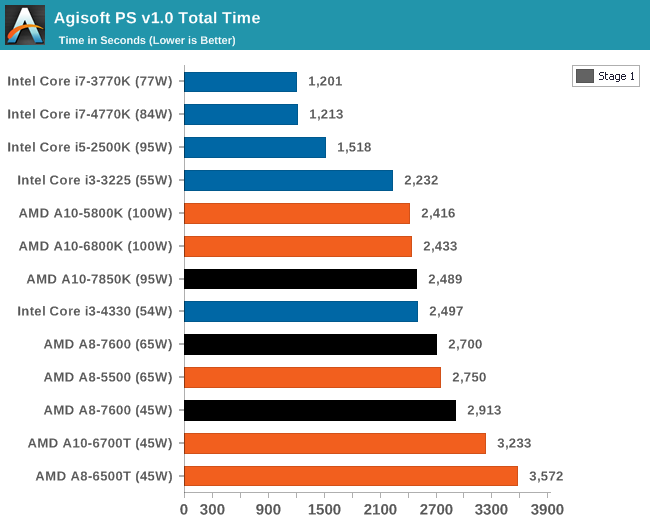
AMD suffers in overall time due to the lack of full-blooded cores and the reliance on single threaded performance in certain parts of the algorithm.
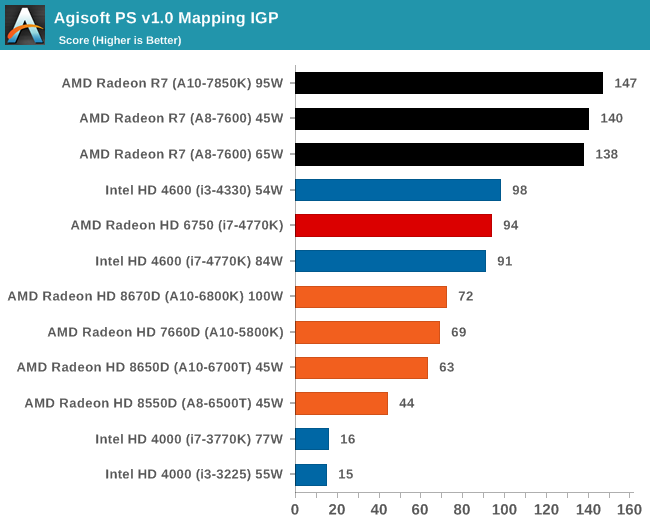
The second stage of the benchmark can be accelerated by the IGP of an APU, and as a result we can see the power of the high end APUs for this work can outshine any CPU we tested today. This is really the promise of HSA, it's just going to take a while to get there for most apps.
3D Particle Movement - link
3DPM is a self-penned benchmark, taking basic 3D movement algorithms used in Brownian Motion simulations and testing them for speed. High floating point performance, MHz and IPC wins in the single thread version, whereas the multithread version has to handle the threads and loves more cores.
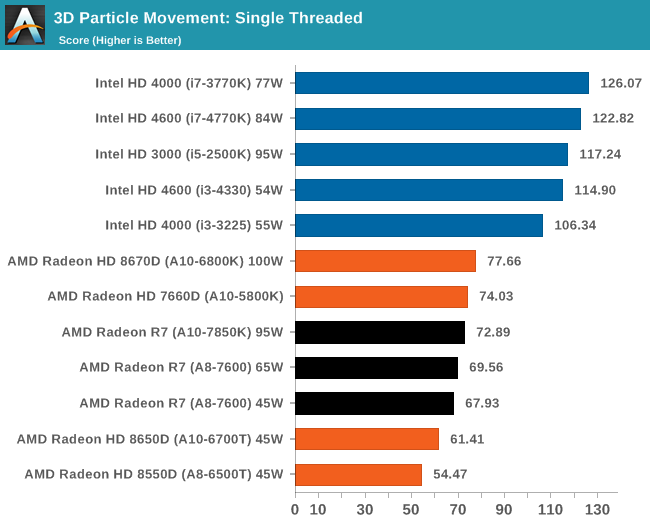
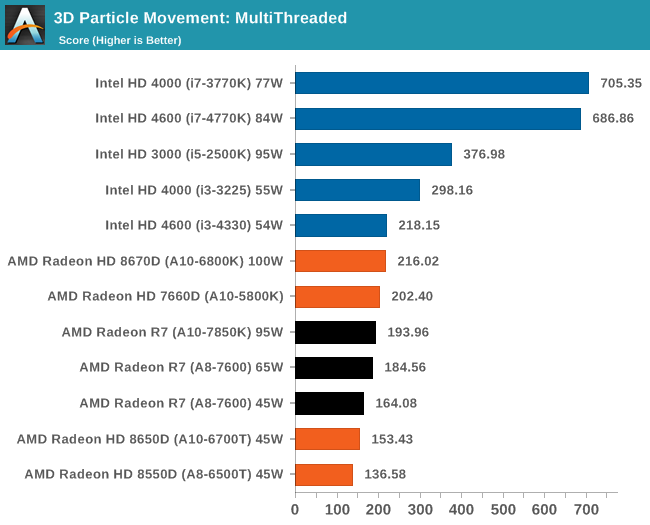
AMD is still suffering a lack of FP performance in our 3DPM benchmark.
WinRAR 5.01 - link
Our WinRAR test from 2013 is updated to the latest version of WinRAR at the start of 2014. We compress a set of 2867 files across 320 folders totaling 1.52 GB in size – 95% of these files are small typical website files, and the rest (90% of the size) are small 30 second 720p videos.
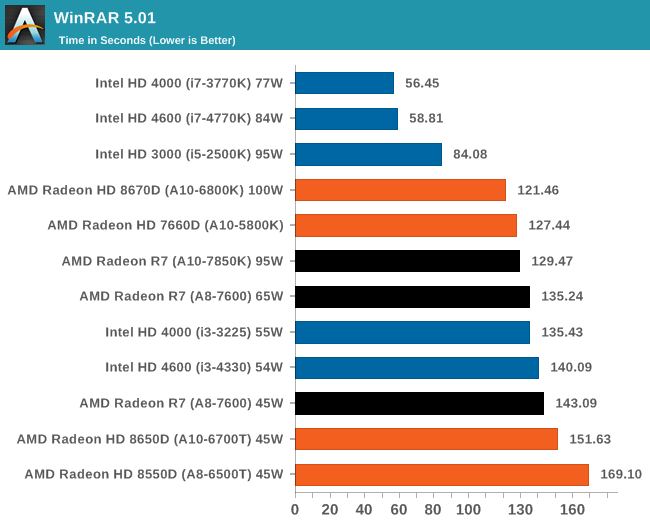
WinRAR loves IPC from the high end Intel chips, but even against the older i5-2500K there is still a deficit. The 45W Kaveri APU however is within fighting distance of its main rival.
FastStone Image Viewer 4.9 - link
Similarly to WinRAR, the FastStone test us updated for 2014 to the latest version. FastStone is the program I use to perform quick or bulk actions on images, such as resizing, adjusting for color and cropping. In our test we take a series of 170 images in various sizes and formats and convert them all into 640x480 .gif files, maintaining the aspect ratio. FastStone does not use multithreading for this test, and thus single threaded performance is often the winner.
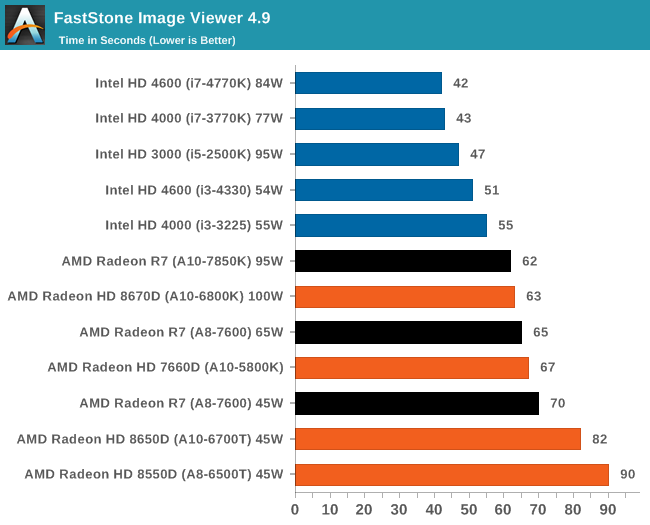
FastStone wants single threaded performance, so Intel wins here again.










380 Comments
View All Comments
Nagorak - Wednesday, January 15, 2014 - link
The fact is these "APUs" are really pretty worthless. If you're going to be seriously gaming then you want to get a discrete graphics card, even a low end one. The problem with AMD's strategy here is that the integrated GPU performance is still so anemic that it's only useful for people who want a budget PC and who don't actually play games. Therefore the "benefits" of having both CPU and GPU on one core are highly questionable.ImSpartacus - Thursday, January 16, 2014 - link
That could be solved if we had a much larger GPU on the APU, right?I want to see at least 12 CUs on the top-end APU, preferably more like 16-20 CUs.
lmcd - Monday, January 20, 2014 - link
Did you miss the whole conversation about memory bandwidth?nader_21007 - Saturday, January 18, 2014 - link
below the charts showing the games performanc, there are two tabs, one for showing avarage frame rate and the other, if you just click on it will show you the suddeframe rates for the apus compared. Minimum frame rate of the iris pro is the lowest and worst among all Apu's compared. It means sudden hangings all over the game. Kaveri and other amd apu's have no such weaknesses because of high performing IGP.Now tell me which is Outperformed?themeinme75 - Saturday, January 18, 2014 - link
the good news is APU-7850/SOC-5200pro just caught up to 4850..cryptik - Monday, March 30, 2015 - link
The R7 consistently beats the Iris Pro. You must have read a different article than everyone else.frozentundra123456 - Tuesday, January 14, 2014 - link
Good review, except he doesn't really address the elephant in the room that even for gaming, a low end cpu like the athlon X4 with a HD7750 will be considerably faster than any APU. So in this regard, I disagree with the conclusions that for low end gaming kaveri is the best solution. It is disappointing actually, that he did not use a HD7750 GDDR5 as the discrete gpu comparison, because that would have given a more direct comparison of how the bandwidth restrictions are affecting Kaveri.I will say though that the low TDP parts seem to get a nice improvement in performance. They actually seem more attractive that the high end, since there is little gaming improvement in the top end vs Richland.
thevoiceofreason - Tuesday, January 14, 2014 - link
Or something like Pentium G2120 (90$ newegg) and HD7770 (90$ ASUS or MSI on newegg after rebate). The difference between such a setup and a top of the line kaveri chip is not even funny. Kind of tragic, really.andrewaggb - Tuesday, January 14, 2014 - link
I agree. I am extremely dissappointed. Cpu performance and GPU performance barely changed from last year's model. HSA is definitely the future, and Mantle may deliver a healthy fps improvement, but I feel like this product has almost no value at launch. It's all depending on future software.I was actually considering a kaveri for a kids pc... but I'm definitely way better off getting an intel cpu and amd gpu.
andrewaggb - Tuesday, January 14, 2014 - link
I guess they did make big gains on TDP. So it's sorta their version of a haswell refresh. But haswell had a larger improvement in both cpu and gpu performance relative to their previous chip.